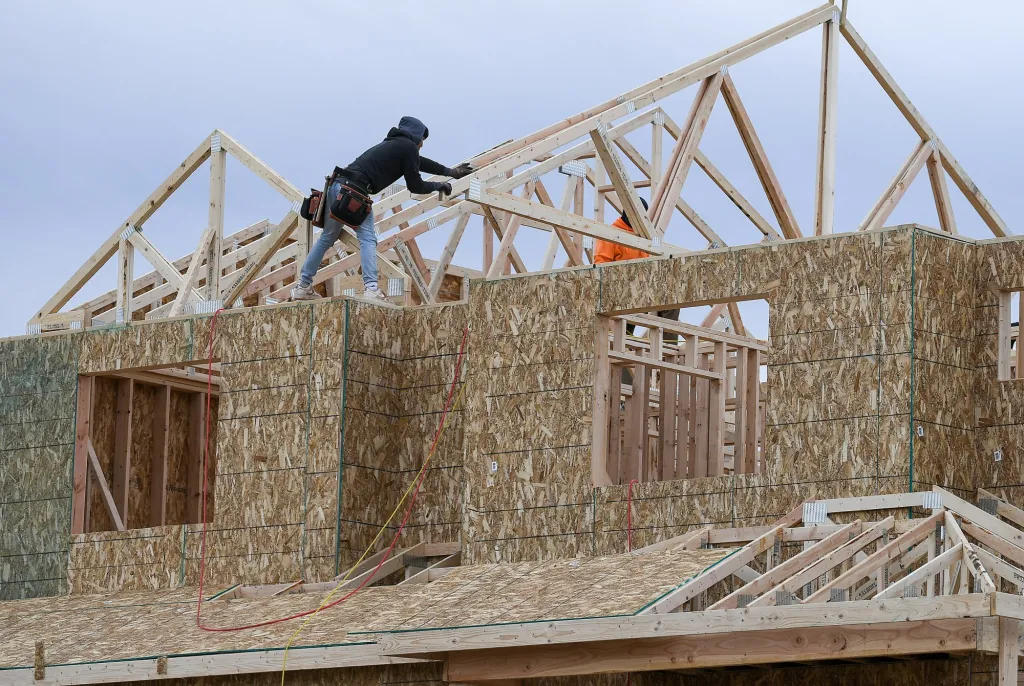
Colorado has made significant strides in reducing its housing shortfall since the pandemic, but that gap could widen again if construction activity continues to slow and housing costs don’t find a way to align more closely with incomes.
The state had a shortfall of 106,000 homes and apartments in 2023, the most recent year available, and needs to build at least 34,100 housing units a year, not counting vacation homes, over the next 10 years to keep up with slower population growth, according to a research brief from the State Demography Office.
That’s a notable improvement from the state’s shortfall of 140,000 homes and apartments in 2019, right before a sharp drop in interest rates during the COVID-19 pandemic unleashed a surge in construction. When the Federal Reserve started to lift interest rates in 2022 and 2023 to combat inflation, new activity slowed, but with a lag.
Slower population gains in Colorado have also reduced demand for new homes and apartments. And some of that reduced popularity appears to reflect a much more expensive housing market.
“It is difficult to statistically examine if the higher cost of living is contributing to slower net migration, but I do believe cost of living, housing, is a contributing factor,” said Brian Lewandowski, executive director at the Leeds School of Business at the University of Colorado Boulder.
The mismatch between what it costs to build a home or apartment versus what the typical household can afford threatens to reverse the gains made in reducing the housing shortfall, and it is an issue the administration of Gov. Jared Polis has made a priority.
“Every Coloradan deserves a place to call home,” said Maria De Cambra, executive director of the Department of Local Affairs in comments accompanying the report. “While we’ve made progress since 2019, this report shows that we still have much work to do. At DOLA, we are committed to continue to work with our partners to provide a home for every Colorado budget.”
It has become much more expensive to build housing on all fronts — land, labor, materials, borrowing costs and regulatory costs. And while incomes continue to rise, they haven’t kept pace.
The Federal Reserve has started to lower its benchmark interest rate again, which should bring some relief.
But Penn Pfiffner, a consulting economist with Construction Economics LLC in Lakewood, said a new round of cost increases is likely because of tighter immigration policies, meaning fewer construction workers, and tariffs on imported goods, which will result in higher materials costs.
“We aren’t seeing yet the increased costs from labor leaving the area, from tariffs hitting on very critical construction materials,” he said. “We might see some slow or delayed activity from developers having to pivot from the denser parts of Denver for multi-family to find better locations elsewhere.”
Development fees charged by local government are another pain point for builders. They average $68,000 per single-family home, which represents 11% of the typical new home price, according to a study of the 16 most active cities and counties by the Home Builders Association of Metro Denver. About 60% of that cost represents water and sewer tap fees.
And ever more complex building codes, covering issues like energy usage and wildfire prevention, while well-intentioned, continue to add to costs.
Builders have found it increasingly difficult to build at a price that the typical household can attain, much less first-time buyers or young renters. More than half of renters and a quarter of homeowners in Colorado are “cost-burdened,” meaning they spend more than 30% of their income on housing, according to an analysis from the Bell Policy Center.
An attainable target
Can Colorado achieve the 34,100 new housing units a year that state demographers say is required to keep the shortfall from growing?
“We are at 19,000 (permits) through July, so we are on track to match last year at 32,000. So yes, that number appears achievable,” Lewandowski said.
How many homes need to be built a year can vary depending on the average household size in a given area. But a rule of thumb is that one new housing unit is needed for every 1.5 to 2 new residents. Colorado, however, has long struggled when it comes to lining up housing supply with population growth.
In the 1990s, builders pulled an average of 33,504 permits a year to accommodate a population that was growing by 75,277 residents a year on average, resulting in undersupply. By the 2000s, the average had accelerated to 38,332 permits a year to accommodate 64,527 new residents per year.
The averages, however, don’t tell the story of that boom-and-bust decade. In 2001, builders pulled 53,914 permits, including 6,229 in June of that year. By 2009, just 9,438 permits were pulled, with a low of 489 in January of that year. Too much building in the early part of that decade, fueled by the dot-com boom and easy lending standards, ended in a surge of forced sales and foreclosures.
Prices fell, demand vanished and overextended builders, as well as the lenders who backed them, were wiped out. Construction capacity was destroyed. By the end of that decade, new supply was down to a trickle just as population growth was about to surge again.
Permits in the 2010s averaged 30,003 a year, too few to accommodate a population that was growing by 71,095 people a year. That resulted in the shortage of 140,000 homes by 2019.
The pandemic changed everything. Interest rates plunged to help forestall an economic collapse, setting off a construction boom. More home and apartment permits were pulled in 2021 than in 2001 in Colorado, according to data tracked by the Federal Reserve of St. Louis.
Since 2020, builders have averaged 45,456 permits a year, while the population has grown by an average of 34,073 people a year. Normally, that wouldn’t be sustainable, except for the huge backlog of needed homes. That surge, fueled by cheap capital, has reversed course.
“We know definitely we are seeing a contraction for residential permits,” said Ted Leighty, CEO of the Home Builders Association of Metro Denver. He notes that single-family permits are down 20% and condo permits are down 10% year-to-date in metro Denver.
The number of homes and condos listed for sale in August in metro Denver was up 22% over the past year, which works out to nearly 3,000 more listings than a year earlier, according to Homes.com. Apartment List estimates that metro Denver’s apartment vacancy rate was nearing 9% in August and monthly rents were down in the high single-digits across the metro area.
The growing inventory of unsold homes and vacant apartments might appear to suggest there is no housing shortfall. But what is available often isn’t affordable to those who need a place to live, and that is a problem nationwide.
“The United States is in desperate need of more homes, especially more moderately priced homes, but it’s not happening. Building permits and new housing starts declined in August, continuing a steep drop-off since the spring. Building permits are now at the lowest level since May 2020, during the height of the pandemic,” said Heather Long, chief economist at Navy Federal Credit Union, in an email.
Long said that building permits nationally are an “anemic” 1.3 million, far short of the 2 million new homes a year needed. And while lower mortgage rates may help, they won’t resolve what is fundamentally a lack of adequate construction.
The volatility is more extreme with multi-family. Between July 2020 and June 2023, builders pulled an average of 47.7 new apartment permits a year per 10,000 residents in metro Denver, a nearly 50% increase from the number averaged between 2014 and 2020. Over the past year, they have pulled 25.1 permits per 10,000 residents, a similarly sized decrease, according to an analysis from the brokerage firm Redfin.
The decline in construction activity comes as the demography office is estimating that population gains in the state will start accelerating again to 50,000 to 55,000 a year through 2035. But those gains may prove elusive unless Colorado, one of the most expensive states to live in outside the coasts, can find a way to better align housing costs with household incomes.
Get more real estate and business news by signing up for our weekly newsletter, On the Block.



